The Windows 10 Review: The Old & New Face of Windows
by Brett Howse on August 25, 2015 8:00 AM EST- Posted in
- Operating Systems
- Microsoft
- Windows 10
Inspired by the Smartphone: Action Center Arrives on the PC
Originally released on Windows Phone 8.1, Action Center is one of many features that have been inspired by the rise of the smartphones. In fact, the end result on Windows 10 is practically identical to what is available on Windows Phone 8.1.
Having all of our programs place their notifications in a single location is as useful on the desktop as it is on the smartphone. You can, at a glance, check out what has happened. Windows Phone 8.1 also introduced several configurable settings toggles, where you could easily enable airplane mode, screen rotation lock, turn off Bluetooth, or more.
Windows 10 offers this same experience, including the customizable toggles. New to Windows 10 though is the ability to add more toggles, and expand the list to display them all. It is very handy for tasks like connecting a Bluetooth speaker, since you can now just use the Connect toggle in Action Center, select the speaker, and away you go.
At this point, everyone is pretty comfortable with notification systems, so we don’t need to dig in here too deep. For the moment, notifications can either be dismissed by swiping them to the right, or selecting them will open the corresponding app. In the not too distant future, apps like Messaging will be actionable from right within Action Center which will be very welcome.
Like practically everything in Windows 10, this is fully customizable and you can even disable Action Center yourself if you find it distracting. This is one of the key points that I have noticed with the launch, is that almost every single feature they have added also contains a way to disable that feature. Compare this to the Windows 8 era, and you can see that Microsoft has certainly opened its eyes and ears to their customers.
More Smartphone features: Wi-Fi Sense, Data Usage, Storage Tracking
Windows Phone, despite its low adoption, has some other very useful functionality that Microsoft is bringing to the desktop. And honestly, it makes just as much sense here as it does on a mobile device. With Windows 10, PCs and phones are converging far more than we may have even thought possible, but I think the idea is that if an idea is good on the phone, why not see if you can adapt it for the PC too?
The first feature is Wi-Fi sense, and this one has likely gotten the most publicity. Enabling Wi-Fi sense lets Windows 10 automatically connect to hotspots, and if the hotspots want you to agree to terms, it will automatically do this and get you connected. It’s a feature I’ve had on my phone for a while now and it is very handy not to have to deal with that all the time. I’m excited for it to come to Windows 10.
The other big piece of Wi-Fi sense is that when connecting to an access point, you can optionally share the information with some of your social networks. If enabled, your outlook.com contacts, Skype contacts, and Facebook contacts can all get access to this network if you opt-in to enabling this feature. In settings, you can also select which group of contacts will get access with check boxes beside all three choices so you can enable or disable whichever ones you desire.
This is a feature that already existed in Windows Phone 8.1, but with so few devices out there it never really got the attention then. When enabled, Wi-Fi Sense shares the network information without the other person ever having to see the pre-shared key. In this sense, it can be more secure than the old way, because they do not have to be told the key, and they have no way of seeing it. If they have Windows 10 and have this feature enabled, they will just get logged into the network. They also cannot share this network with any of their contacts. This is a one time share, and any contacts which receive it can’t share it again.
Now remember, this is an opt-in feature, and it is per network. There is no “always share” option. Each time you connect to a new network, there will be a check box that is unchecked by default asking you if you want to share this.
Still, this can be an issue especially at a corporate environment where they are using pre-shared keys (likely because they lack the infrastructure for other methods) and it would be a bad thing if someone added the work network to their phone and shared it with their friends. For this reason, you can add _optout to the SSID of the wifi network to disable this completely.
Once a network is shared, it may take a couple of days for it to be accessible on contacts devices, and if you remove access, it may take a couple of days more before it goes away.
The implications of this change are that it should make it a lot easier to have friends and family get access to your Wi-Fi if that is what you want. From a security standpoint, it is a little dicey. The actual network information is encrypted during the exchange, but that doesn’t mean an enterprising person won’t gain access to the information once it’s on their computer.
You can at least use one feature without the other. If you want easier access to hotspots, enable that, and leave the Wi-Fi sharing disabled.
Windows 10 also gets what Windows Phone called Data Sense. It keeps track of all of your network activity over the last thirty days, and it displays it in a list which is per-application. It is a great tool to see how much you use per month, and if you have a rogue application using tons of bandwidth. Windows Phone allows you to set the maximum limit as well, and you can set it to not just a 30 day period. I expect this will improve over time as Windows 10 evolves.
Another pickup from Windows Phone is Storage Sense, or so it is called on that platform. On Windows 10 it is just Storage settings. Here you can easily set where documents, music, pictures, and videos are stored, and this will be very handy for devices with not a lot of storage out of the box, such as low cost tablets or notebooks. It will also give you a list of all of the things on your drive to give you an idea where your space is being used.
One feature of Storage settings which is available in the UI but greyed out at the moment is the ability to redirect Windows Store apps to another location. Once again, for low cost devices, you may have some SD storage available which you can then move your apps to. Or, maybe you have a smaller SSD and want to store those apps on a secondary disk based drive. This was originally intended to ship with Windows 10 but unfortunately they have not yet ironed all of the bugs out of it, so it is ready to go in the UI, but is currently greyed out.


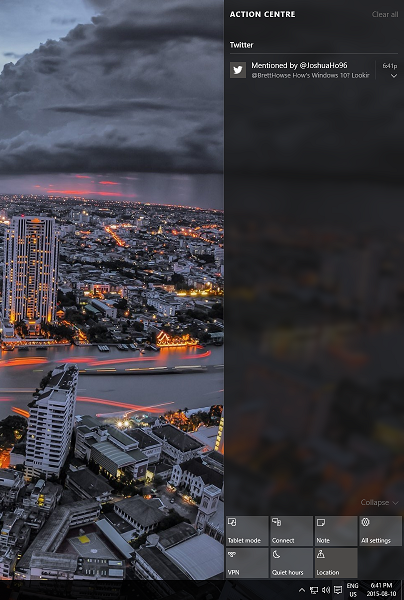
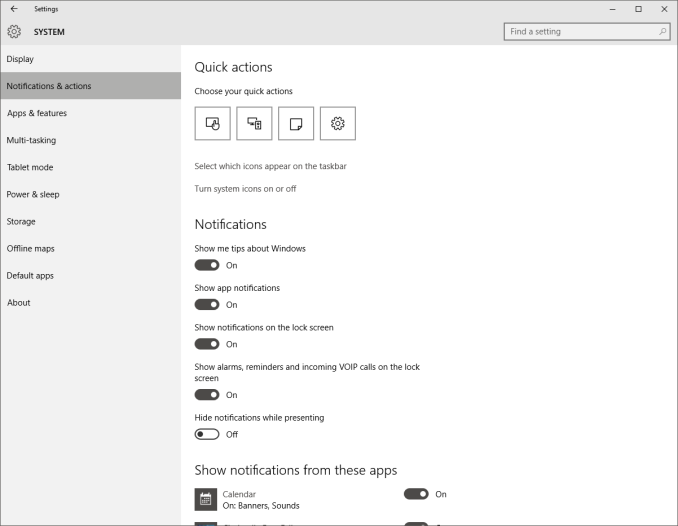

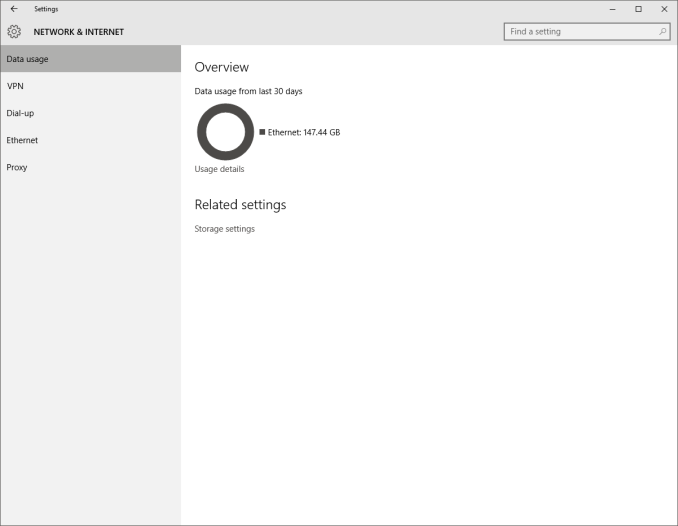
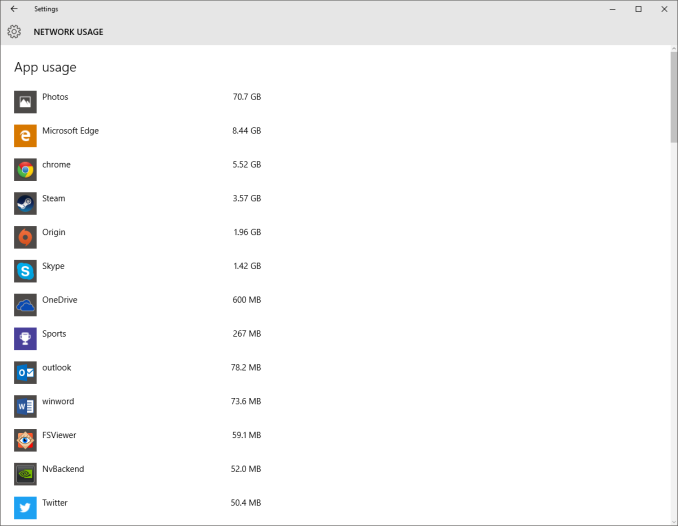
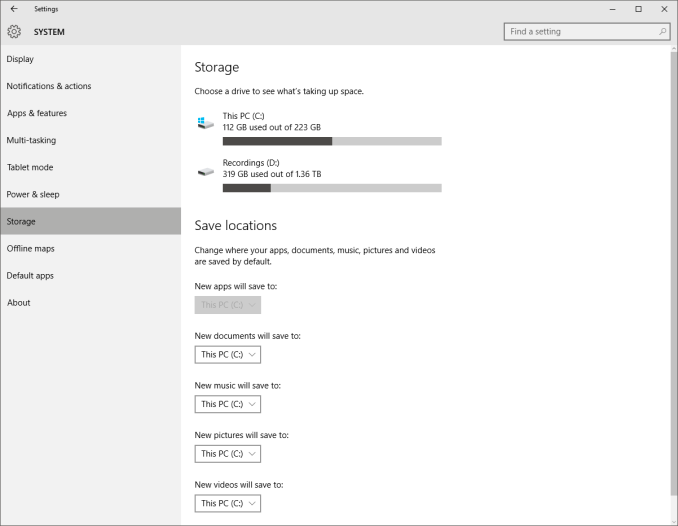
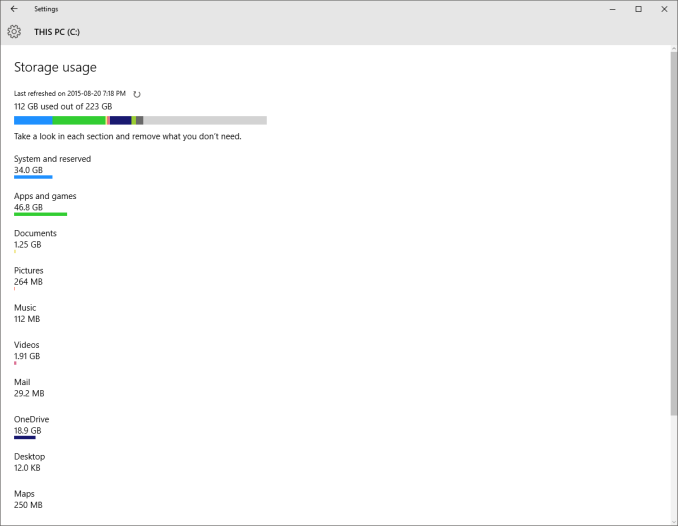








293 Comments
View All Comments
SeleniumGlow - Wednesday, September 2, 2015 - link
What about the changes and enhancements to the Audio stack. The new windows 10 Audio stack is redesigned completely so that it reduces inputs and recording latency. This supposedly makes windows 10 Audio API on par with something like ASIO, by reserving a complete CPU core.Rickkins1 - Thursday, September 3, 2015 - link
Bwahahahaha, this is comedy gold. Browse microsoft's forums to see the multitude of complaints about win10 breaking sound cards etc.Rickkins1 - Wednesday, September 2, 2015 - link
I'd just like to thank microsoft for that totally unbiased review of windows10.But seriously, c'mon, will ya...?? Do you really take us for complete idiots...??
At least have the honesty to label such a piece as "advertisement".
Oracv4Prez - Friday, September 4, 2015 - link
Amongst all the glow and gushing comments I think that Windows 10 is horribly flawed. Lets start with the upgrade: Th new font renders incredibly poorly on my screen (1920 x 1200) Samsung and looks horribly blocky - like an ancient PC from the 80's. Secondly, half of the programs dont work anymore and when I tried to open Microsoft's own office applications, the links all failed.SO you want to try out Edge??? No doubt it is faster for all the sites I visit. But...what about your bookmarks/favorites. It wont except anything but IE 11 and if you have them neatly sorted and try to move from another browser to IE the organisation dies.
And finally when you think you have a few things working, it crashes. Oh well, we all have the dreaded blue screen of death now and them. It politely tells you that there is an error so it will restart. You could wait --- and wait ... and wait for something to happen, but no - nothing!!!!
Tried the solutions on the web, but obviously there are still a LOT of holes to patch. Oh, and the last update (before I banished it) did more damage than the initial install, causing perfectly functioning applications to crash/or the link to disappear.
Rating: - pre-beta software status. Use at your peril!
TheReviewWriter - Monday, September 7, 2015 - link
I love it Very smooth makes me feel organized and smart LOL :)Ramon Zarat - Monday, September 14, 2015 - link
No matter how you slice it, Windows 10 is a step in a VERY wrong direction. If the product is free, YOU become the product. I *HATE* this business model consisting of trading most if not all your privacy *AND* control over your product for $149.00 (typical Windows license price).The entire M$ product portfolio is going into that direction. Their first failed move was the Metro atrocity to force you into the M$ store with Windows 8. Then you had Office 365 you rent for a monthly fee FOREVER instead of owning the product. Then they tried to impose an "always on" connection to the XB1 + restriction on sharing games and failed miserably. Now, it's the turn of the entire OS to be free, but at what price?
I'm a paying M$ customer since Windows 95 but this time, I'll wait until a fully hacked and fully sanitized version of Windows 10 comes out, including with the choice to install or not "upgrades" from Windows update and turning off and all the spyware shit for good.
I want to own my stuff, not rent them forever, not for free with tons of negative impacts either. I want to control what I own. I want my data stored locally, not in the cloud. And finally, I don't want to share anything that concerns only me. The *ONLY* technological improvement Windows 10 bring to the table compared to Windows 7 that is worthy of mention to me is DirectX12. If hackers can one day bring DX12 to Win7, I'll simply never upgrade.
clarkrptg - Tuesday, September 15, 2015 - link
I would think twice about upgrading to Windows 10. I did so and now have a completely unusable computer with a black screen. I guess I should have known better,but don't understand how Microsoft gets away with this crap over and over and over again. I am moving to Mac . . . no doubt about it. I googled the issue and find a comment from Microsoft, oh, gosh golly,yes, resulting black screens are a problem. Oh, gee whiz, sorry about that. Take your computer into a Microsoft store, blah, blah, put back to factory settings, blah, blah. I have a suggestion for you Microsoft . . . I WILL NEVER BUY ANOTHER MICROSOFT COMPUTER AGAIN.Miller1331 - Tuesday, December 1, 2015 - link
Such an upgrade over Windows 8. Microsoft have done good this timeConcettaBustamante - Wednesday, June 29, 2016 - link
My colleagues were searching for NY DTF IT-2663 a few weeks ago and used a document management site that hosts a lot of fillable forms . If others want NY DTF IT-2663 too , here's a link http://goo.gl/JQA7yVkelli stark - Tuesday, February 20, 2018 - link
WINDOWS 10 reviews are coming positive mostly like start menu is back, internet explorer is replaced by Microsoft edge there are soo many changes that are done to windows 10 you can also check reviews on this site https://www.ticketgateway.com/profile/user_profile... and you will get more updates about Windows 10